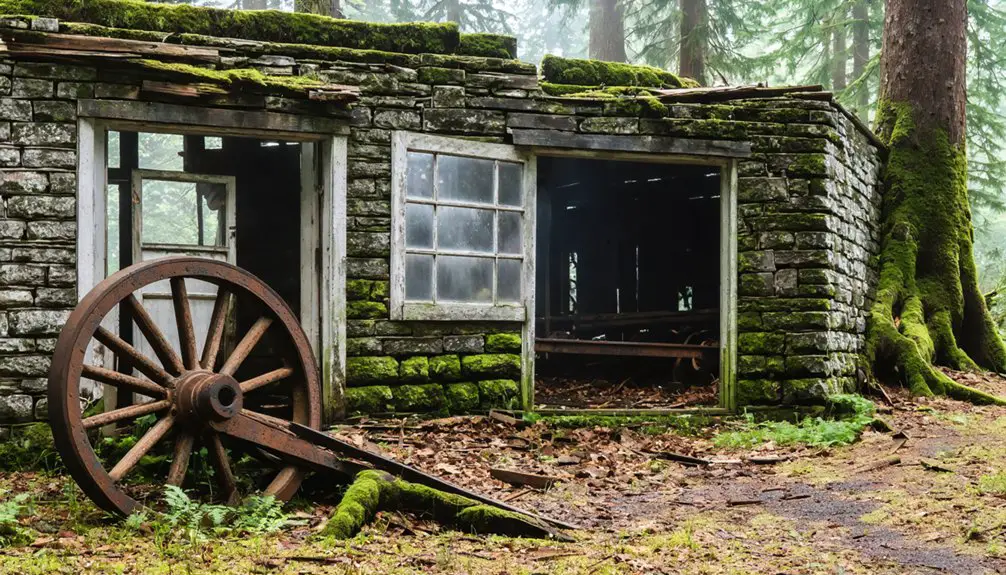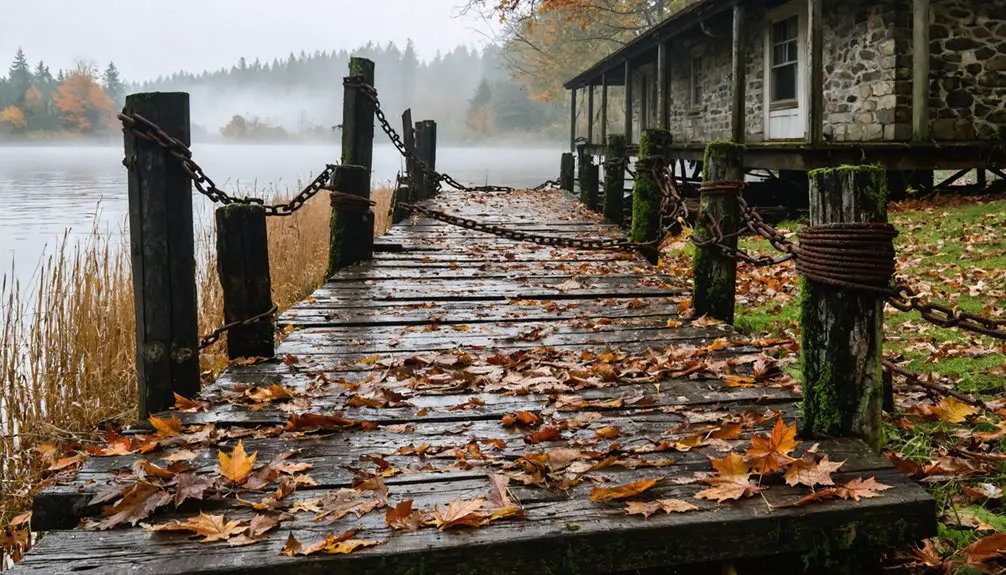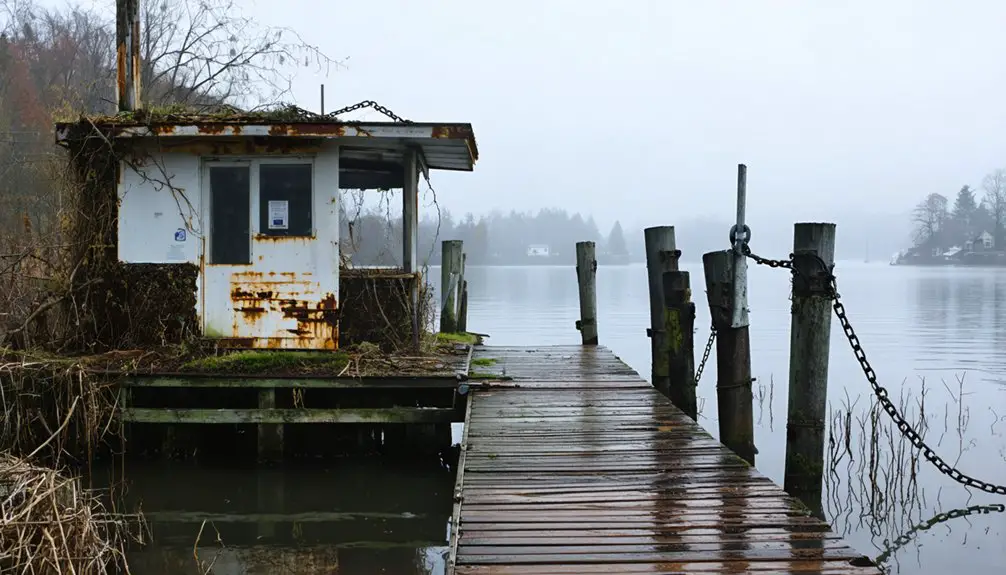You’ll find Boone’s Ferry’s legacy along Oregon’s Willamette River, where Alphonso Boone (Daniel Boone’s grandson) established an essential transportation hub in 1847. The ferry operated for 107 years, connecting Portland to Salem and serving as a commercial center with trading posts and merchant stores. While the ferry made its final crossing in 1954 after the Boone Bridge’s construction, historical markers and Tauchman House preserve this pioneer settlement’s rich story.
Key Takeaways
- Boones Ferry was a thriving river crossing and commercial hub established in 1847 by Alphonso Boone along the Willamette River.
- The settlement at Boone’s Landing included trading posts, stores, and ferry operations serving travelers between Portland and Salem.
- The community effectively ended in 1954 when the Boone Bridge and Interstate 5 replaced the ferry system.
- Original structures and ferry infrastructure were abandoned after the bridge construction, leaving minimal physical traces today.
- The site’s legacy remains through Wilsonville’s memorial park and the preserved Tauchman House from the ferry operation era.
The Legacy of Alphonso Boone
While many pioneer settlements in Oregon trace their origins to anonymous settlers, Boone’s Ferry emerged from the remarkable legacy of Alphonso Boone, grandson of legendary frontiersman Daniel Boone.
You can see Boone’s heritage reflected in his pioneering spirit when he ventured west from Missouri in 1846, claiming 1,000 acres along the Willamette River. He’d already proven himself as a successful trader, operating posts that supplied countless emigrants heading west on the Oregon Trail. Together with his son Jesse, he established a busy trading post near the ferry landing that became a hub for local commerce.
When he established his ferry service in 1847, he wasn’t just creating a business – he was building an essential transportation link that would serve Oregon for over a century. His strategic vision created a direct route between Salem and Portland, bypassing Oregon City and forever shaping the region’s development. The ferry operation would continue serving travelers and locals alike for 107 continuous years until its final crossing in 1954.
Life Along the Willamette River
Anyone exploring the Willamette River in the 1830s would’ve encountered a landscape in rapid change. You’d have witnessed French-Canadian settlers establishing communities like Champoeg and St. Paul, while steamboats navigated the waters, transforming settlement patterns along the fertile valley.
These settlers, many former Hudson’s Bay Company employees, brought livestock and farming expertise to the region. The river ecosystems attracted diverse groups seeking opportunity. The rich valley supported an estimated 15,000 indigenous people before European settlement. You’d have seen farmers claiming land under the Donation Land Act, cultivating wheat in the humid climate and rich soils.
Through Oregon City’s bustling port, agricultural products flowed to distant markets, especially during the California Gold Rush. But this prosperity came at a cost – the native Kalapuya population had been devastated by malaria outbreaks, with their numbers plummeting by 90%.
Native American Partnerships
Before establishing their ferry service in 1847, the Boones family forged essential partnerships with the Kalapuya people, particularly the Tualatin band who were skilled oarsmen.
The native contributions to this significant transportation link can’t be understated – they helped operate the ferry for over a century while preserving their cultural heritage. Jesse Boone maintained ferry operations until his tragic death from a gunshot wound in 1872. The State of Oregon later assumed control of the ferry operations in the early 1900s.
The Kalapuya people’s vital role in operating this historic ferry service showcases their enduring cultural legacy and maritime expertise.
You’ll discover these fascinating aspects of the indigenous-settler partnership:
- The ferry’s original design used native canoes joined by a platform
- The route followed ancient Kalapuya trails connecting Portland to Salem
- Native oarsmen helped transport thousands of travelers, livestock, and vehicles
- The Tualatin band’s expertise as river navigators proved critical for the ferry’s success
Today, the Kalapuya’s descendants continue their cultural preservation through the Confederated Tribes of the Grand Ronde and Siletz.
From Water to Road: A Century of Change
As Oregon’s transportation needs evolved throughout the nineteenth century, Boones Ferry emerged as an essential crossing point on the Willamette River, transforming from a simple platform supported by two native canoes into a sophisticated cable ferry system.
You’d have witnessed a remarkable transportation evolution as the ferry adapted to handle everything from horse-drawn buggies to automobiles, making up to 300 crossings daily at its peak.
Tuality Indian oarsmen originally powered the ferry’s operations across the river, establishing a crucial link between Oregon City and Butteville.
The ferry service remained in private ownership until the early 1900s when Clackamas County assumed control of operations.
River navigation gradually gave way to land-based travel, and by the mid-twentieth century, you’d have seen the writing on the wall.
The construction of the Boone Bridge and Interstate 5 in 1954 marked the end of an era, permanently shifting the region’s transportation from water to road.
This change mirrored broader trends across the Willamette Valley as communities embraced modern infrastructure and highway travel.
Early Commerce and Trade Routes
When Alphonso Boone established his ferry service in 1847, he laid the foundation for one of Oregon Territory’s most crucial commercial arteries. His son Jesse blazed Boones Ferry Road, creating a significant link between Portland and Salem that would serve pioneer transportation needs for generations.
You’ll find the impact of this route on agricultural commerce was profound, as evidenced by these key developments:
- The ferry carried thousands of horses, livestock, and vehicles across the Willamette.
- Local merchants established stores and supply depots at Boone’s Landing.
- Farmers gained direct access to Portland and Salem markets.
- The route paralleled indigenous trails, improving accessibility for settlers.
This commercial lifeline transformed the region, enabling trade that would shape Oregon’s early economy and establish lasting transportation corridors. The Tauchman House stood as a prominent landmark, serving as the ferry operator’s residence for three decades. The ferry service maintained its vital role for 107 years before being decommissioned when the Boone Bridge opened in 1954.
Daily Operations and Ferry Technology
While Jesse Boone initially relied on two joined canoes propelled by Kalapuya oarsmen to transport pioneers across the Willamette, the ferry’s technology evolved considerably during its 107-year operation.
You’d have seen dramatic improvements when cable technology replaced manual rowing, allowing the vessel to carry up to 12 automobiles per crossing.
Ferry operations demanded constant adaptation to nature’s challenges. The crew had to navigate fluctuating water levels and strong currents while maintaining the cable system that guided the vessel.
Operating a ferry meant battling nature daily, as crews faced ever-changing river conditions while keeping vital cable systems functional.
At its peak, you’d have witnessed up to 300 crossings daily, though weather and seasonal changes often affected schedules. The shift from oar to cable propulsion boosted reliability and capacity, but it also meant regular mechanical maintenance to keep the crossing running smoothly.
Community Growth and Settlement

Since establishing Boone’s Landing in 1846, Alphonso Boone – grandson of legendary frontiersman Daniel Boone – transformed the north shore of the Willamette River into a bustling settlement hub.
The settler dynamics quickly evolved around the ferry’s strategic location, creating a vibrant community that served as an essential link between emerging regional towns.
The ferry’s significance in shaping local development can’t be overstated.
Here’s how it impacted growth:
- Created a commercial focal point for trade and transportation
- Drew settlers who established homesteads along the riverbank
- Provided employment opportunities for both settlers and local Kalapuya people
- Sparked development of connecting infrastructure like Market Road
This transportation nexus fostered economic activity through passenger movement, livestock transport, and goods shipment, establishing Boone’s Landing as a critical Willamette Valley crossroads.
The Final Crossing
You’ll find that Boones Ferry remained operational until 1954, serving countless travelers and farmers crossing the Willamette River near present-day Wilsonville.
The ferry’s final years saw it transporting automobiles and pedestrians, a far cry from its humble beginnings with canoes and horses in 1847.
When the I-5 Boone Bridge opened in 1954, it permanently replaced the historic water crossing, marking the end of over a century of ferry service that had been essential to the region’s growth.
Last Ferry Operation Details
After operating continuously for 107 years, the historic Boones Ferry made its final crossing of the Willamette River in 1954, marking the end of an era in Oregon’s transportation history.
In its last years of service, this vital transportation link demonstrated impressive operational capacity that reflected the region’s growth and evolving needs.
Key features of the final ferry operation included:
- Capability to transport up to 12 cars simultaneously
- Approximately 300 daily crossings to meet increasing demand
- Cable-drawn system that accommodated both vehicles and livestock
- State of Oregon management overseeing the shift to the Boone Bridge
You can trace the ferry’s transportation evolution from its humble beginnings under Jesse Boone’s private operation to its final days as a state-controlled crossing, showcasing over a century of ferry history adapting to the region’s changing needs.
Bridge Replaces Water Crossing
When the Oregon Department of Transportation completed the Boone Bridge in July 1954, it marked a definitive end to the historic Boones Ferry crossing.
You’d find the new four-lane bridge just east of the old ferry landings near Wilsonville, carrying Interstate 5 traffic across the Willamette River.
This bridge construction project transformed regional transportation, replacing a ferry service that had operated since 1847.
While the ferry change closed a fascinating chapter in Oregon’s pioneer history, the bridge opened new possibilities for connecting Portland to Salem.
You’ll notice how the $4 million structure, later widened to six lanes in 1970, reflected the valley’s rapid urbanization.
Preserving Pioneer History

While many Oregon ghost towns have faded into obscurity, the legacy of Boones Ferry lives on through dedicated preservation efforts.
Unlike many forgotten settlements, Boones Ferry’s pioneering spirit endures through careful preservation of its historical legacy.
You’ll find pioneer storytelling and historical preservation efforts that keep this essential piece of Oregon’s heritage alive for future generations.
Today, you can explore several key sites that commemorate this historic crossing:
- A memorial park stands at the original ferry crossing site in Wilsonville
- The preserved Tauchman House, home to a 30-year ferry operator
- Marked historical sites at Boone’s Landing, the birthplace of Wilsonville
- The nearby Oregon Korean War Memorial, which adds to the area’s historical significance
Local historical societies continue protecting these landmarks while maintaining the oral histories from Boone family descendants, ensuring this significant chapter of pioneer history won’t be forgotten.
Frequently Asked Questions
What Happened to Alphonso Boone’s Descendants After the Ferry Closed?
You’ll find that after the ferry closed, the Boone family dispersed from direct ferry operations, likely relocating or pursuing different businesses, though their ferry legacy lives on through local landmarks and historical recognition.
How Much Did It Cost to Cross the Ferry in Different Eras?
You’d have paid 25 cents with your horse in the 1850s, while modern ferry tolls have risen considerably – like the Canby Ferry’s $5 car fee today, reflecting economic impacts over time.
Were There Any Notable Accidents or Disasters During Ferry Operations?
While operational hazards existed, you won’t find records of major ferry accidents during Boones Ferry’s century of service. The only documented fatality was Jesse Boone’s death in a shooting near the crossing.
What Indigenous Artifacts Have Been Found Near the Ferry Crossing Site?
Like scattered breadcrumbs of indigenous history, you’ll find stone tools and projectile points near the crossing, though artifact preservation efforts haven’t fully documented specific items from the immediate ferry location.
Did the Ferry Operate During Extreme Weather Conditions or Seasonal Floods?
You’ll find that ferry operations continued through most weather impacts, with skilled Kalapuya oarsmen and a cable system enabling year-round crossings, even during seasonal floods and storms.
References
- https://en.wikipedia.org/wiki/Boones_Ferry
- https://www.youtube.com/watch?v=Vvg1ItAeZ3o
- https://wilsonvillechamber.com/visitors/history-and-heritage/
- https://oregontic.com/oregon-historical-markers/boones-landing-2/
- https://www.oldoregonphotos.com/boones-ferry-near-wilsonville.html
- https://sites.rootsweb.com/~rdrunner/web_data/p45614.htm
- https://en.wikipedia.org/wiki/Alphonso_Boone
- https://oregon-8511f7-19520d4234c-64d94ee027adc.webflow.io/points-of-interest/pnineteen
- https://portlandtribune.com/2019/11/05/hidden-history-boone-family-made-their-mark-on-portland/
- https://www.oregonhistoryproject.org/narratives/this-land-oregon/resettlement-and-the-new-economy/a-changing-landscape-and-the-beginnings-of-white-settlement/



